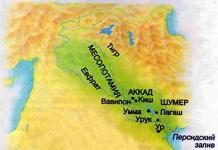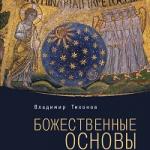Translated from ancient Greek, the name “Mesopotamia” means Mesopotamia. It was on the territory of Mesopotamia that such ancient civilizations as Sumer were born.
This is a huge land between two rivers - the mouths of the Tigris and Euphrates form a wide valley before flowing into the Persian Gulf. But this area was very swampy and was a desert.
The appearance of the first settlers: features of the area
It took people a lot of effort and time to make this land suitable for life. They learned to drain places where there were swamps using dams and canals and irrigate the desert. But it was water that was the main breadwinner of the people who inhabited Mesopotamia.
The only thing that was sorely lacking in Mesopotamia was metal ores. But it is still known that they used tools made of copper, so it is believed that they obtained metals from other territories or exchanged them with other civilizations.
The problem was also the salinity of the soil, which is often associated with the subsequent decline of the civilizations of Mesopotamia. In Mesopotamia there was a lack of rain moisture and constant dry, sandy winds.
The emergence of civilization
The Sumerian civilization settled in the lower reaches of the Tigris and Euphrates. It is still unknown from what land the Sumerians came to Mesopotamia, and it is unknown how their language appeared. It was they who learned to cultivate the land so that it would be suitable for farming and continuing life.
The Sumerians built canals that drained the area flooded by rivers, and stored the water in specially built reservoirs. They could use it if there was a drought.
Thus, the first artificial irrigation system arose on the territory of Mesopotamia. It was invented about 6 thousand years ago. The Sumerians are also known for the fact that it is to them that we owe the emergence of writing - this civilization was the first to invent it.
Features of the civilization of Mesopotamia
The settlements of the ancient Sumerians were city-states that were located on hills, surrounded by protective walls.
It is noteworthy that at first the cities were headed by priests - they had greater power, multiple types of property, vast lands and wealth. Only later did kings begin to be considered rulers. These were entire dynasties of kings who passed on power by inheritance.
The Mesopotamian civilization is different from other early civilizations. For example, Ancient Egypt was a significantly isolated country. But in Mesopotamia everything was completely different; at the first centers of civilization that emerged, Akkadian tribes from the north began to settle in this territory.
Soon, next to the civilization of Mesopotamia, another state was formed - Elam, which constantly used the territory and crops of Mesopotamia.
By the 4th millennium BC. include the formation of full-fledged city-states, their names were Ur, Nippur and Lagash. This is the first example of settlements that had a power structure, a defined territory and borders, an army and even laws.
One of the most amazing places on earth, this is the place where the first states arose, and then the first empires. The Greeks called this area Mesopotamia, that is " Mesopotamia“, in our country it is more customary to say “Mesopotamia” - a giant river valley in Western Asia, bounded at the edges by the flow of the Tigris and Euphrates rivers.
The region called Mesopotamia stretches from the mountains of Armenia in the north to the Persian Gulf in the south. In the west it borders on the Syrian-Mesopotamian steppe, and in the east on the mountain ranges of Western Iran.
The middle and southern parts of Mesopotamia are a plain created by river sediments Tiger And Euphrates, which, periodically spilling, fertilize and irrigate the land.
The tiger originates in the mountains of Armenia, south of Lake Van. The sources of the Euphrates lie east of Erzurum at an altitude of 2 thousand meters above sea level. The Tigris flows very fast, and despite the fact that this river is 750 km shorter than the Euphrates, it carries twice as much water as the slow-flowing Euphrates, whose length reaches 2,600 km.
The banks of the Euphrates are lower than the banks of the Tigris, so the Euphrates floods a much larger area and its flood lasts longer than the Tigris flood, lasting from mid-March to September.
The current Mesopotamia is very different from how this area looked thousands of years ago, during the era of the Sumerian-Akkadian kingdom, because over the past five thousand years the beds of both rivers have changed significantly. Ancient cities of Sumer and Akkad, such as Sippar, Kish, Nippur, Shurup-pak, Uruk And Larsa, were located on the banks of the Euphrates, as the surviving inscriptions indicate. Now the ruins of these cities lie to the east of the modern river bed. The tiger also moved its course. Its current deviated to the northeast.
Thus, the two rivers were closer to each other than they are now. Thus, the area of the plain available for irrigation was somewhat smaller.
The Tigris and Euphrates rivers were the main not only irrigation, but also transport routes of the country; both rivers connected Mesopotamia with neighboring countries, with ancient Armenia (Urartu), Iran, Asia Minor, Syria.
The territory of Mesopotamia - the river valley of the Tigris and Euphrates rivers in the Middle East
Natural conditions and resources of Mesopotamia
Periodic floods of the Tigris and Euphrates, caused by melting snow in the mountains of Armenia, had a certain significance for the development of agriculture based on artificial irrigation. Sumer, located in the south of Mesopotamia, and Akkad, which occupied the middle part of the country, were somewhat different from each other in climatic terms.
In Sumer, winter was relatively mild, and the date palm could grow wild here. In terms of climatic conditions, Akkad is closer to Assyria, where snow falls in winter and the date palm does not grow wild.
The natural wealth of Southern and Central Mesopotamia is not great. Unless fat and viscous clay - silty river sediments were an excellent raw material in the hands of the primitive potter. By mixing clay with asphalt, the inhabitants of ancient Mesopotamia made a special durable material, which replaced them with stone, rarely found in the southern part of Mesopotamia. Equally characteristic of Mesopotamia is the lack of metal, which made the local population dependent on the northern and eastern metallurgical regions.
The flora of Mesopotamia is also not rich. The ancient population of this country acclimatized cereals, barley and wheat. The date palm and reed, which grew wild in the southern part of Mesopotamia, were of great importance in the economic life of the country. Obviously, the local plants included sesame (sesame), which was used for making oil, as well as tamarisk, from which sweet resin was extracted.
The oldest inscriptions and images indicate that the inhabitants of Mesopotamia knew various breeds of wild and domestic animals. In the eastern mountains there were sheep (mouflons) and goats, and in the swampy thickets of the south there were wild pigs, which were tamed already in ancient times. The rivers were rich in fish and poultry. Various types of poultry were known in both Sumer and Akkad.
The natural conditions of Southern and Central Mesopotamia were favorable for the development of cattle breeding and agriculture, requiring the organization of economic life and the use of significant labor for a long time.
Settlement of Mesopotamia by people
The oldest settlements in the middle part of Mesopotamia appeared in the Late Zeolite era. The tribes that inhabited Mesopotamia in ancient times lived on islands rising among the swamps. They built their settlements on artificial earthen embankments.
By draining the surrounding swamps, they created an ancient artificial irrigation system. As the finds at Kish indicate, they used microlithic tools. These tribes may have belonged to the most ancient ethnic layer of Western Asia.
“Everyone will converge in Mesopotamia,
Here is Eden and here is the beginning
Here once in common speech
The Word of God sounded..."
(Konstantin Mikhailov)
While wild nomads roamed the territory of ancient Europe, very interesting (sometimes inexplicable) events were taking place in the East. They are colorfully written about in the Old Testament and other historical sources. For example, such famous biblical stories as the Great Flood happened precisely in the territory of Mesopotamia.
Without any embellishment, ancient Mesopotamia can be called the cradle of civilization. It was on this land that the first eastern civilization arose around the 4th century BC. Such states of Mesopotamia (Ancient Mesopotamia in Greek) as Sumer and Akkad gave humanity writing and amazing temple buildings. Let's go on a journey through this land full of secrets!
Geographical position
What was the name of Mesopotamia? Mesopotamia. The second name of Mesopotamia is Mesopotamia. You can also hear the word Naharaim - this is also her, only in Hebrew.
Mesopotamia is a historical and geographical territory located between and the Euphrates. Now there are three states on this land: Iraq, Syria and Türkiye. The history of Mesopotamia developed precisely in this territory.
Located in the very center of the Middle East, the region is bounded on the west by the Arabian Plateau and on the east by the foothills of the Zagros Mountains. In the south, Mesopotamia is washed by the waters of the Persian Gulf, and in the north rise the picturesque Ararat Mountains.
Mesopotamia is a flat plain stretching along two great rivers. Its shape is similar to an oval figure - such is the amazing Mesopotamia (the map confirms this).
Division of Mesopotamia into regions
Historians conditionally divide Mesopotamia into:

On the territory of Ancient Mesopotamia, four ancient kingdoms existed at different times:
- Sumer;
- Akkad;
- Babylonia;
- Assyria.
Why did Mesopotamia become the cradle of civilization?
About 6 thousand years ago, an amazing event occurred on our planet: two civilizations arose at about the same time - Egypt and Ancient Mesopotamia. The character of civilization is both similar and different from the first ancient state.

The similarity lies in the fact that both arose in territories with conditions favorable for human life. They are not similar in that each of them is distinguished by a unique history (the first thing that comes to mind: there were pharaohs in Egypt, but not in Mesopotamia).
The topic of the article, however, is the state of Mesopotamia. Therefore, we will not deviate from it.
Ancient Mesopotamia is a kind of oasis in the desert. The area is fenced on both sides by rivers. And from the north - by mountains that protect the oasis from humid winds from Armenia.
Such favorable natural features made this land attractive to ancient man. It surprisingly combines a comfortable climate with the opportunity to engage in farming. The soil is so fertile and rich in moisture that the grown fruits are juicy and the sprouted legumes are tasty.
The first to notice this were the ancient Sumerians, who settled this territory about 6 thousand years ago. They learned how to skillfully grow various plants and left behind a rich history, the mysteries of which are still being solved by passionate people to this day.
A little conspiracy theory: about the origin of the Sumerians
Modern history does not answer the question of where the Sumerians came from. There are many assumptions about this, but the scientific community has not yet come to a consensus. Why? Because the Sumerians stood out strongly from the rest of the tribes inhabiting Mesopotamia.
One of the obvious differences is the language: it is not similar to any of the dialects spoken by residents of neighboring territories. That is, it has no similarities with the Indo-European language - the predecessor of most modern languages.
Also, the appearance of the inhabitants of Ancient Sumer is not at all typical for the inhabitants of those places. The tablets depict people with smooth oval faces, surprisingly large eyes, delicate facial features and above average height.

Another point that historians pay attention to is the unusual culture of the ancient civilization. One of the hypotheses says that the Sumerians are representatives of a highly developed civilization that flew from Space to our planet. This point of view is quite strange, but has a right to exist.
How it really happened is unclear. But one thing can be said with certainty - the Sumerians gave a lot for our civilization. One of their undeniable achievements is the invention of writing.
Ancient civilizations of Mesopotamia
Different peoples inhabited the extensive territory of Mesopotamia. We will highlight two main ones (the history of Mesopotamia would not be so rich without them):
- Sumerians;
- Semites (to be more precise, Semitic tribes: Arabs, Armenians and Jews).
Based on this, we will talk about the most interesting events and historical figures.
Sumer: a brief historical background
It was the first written civilization to emerge in southeastern Mesopotamia from the 4th to 3rd centuries BC. Now in this area there is the modern state of Iraq (Ancient Mesopotamia, the map again helps us orient ourselves).

The Sumerians are the only non-Semitic people on the territory of Mesopotamia. This is confirmed by numerous linguistic and cultural studies. Official history says that the Sumerians came to the territory of Mesopotamia from some mountainous Asian country.
They began their journey through Mesopotamia from the east: they settled along river mouths and developed irrigation. The first city where representatives of this ancient civilization stopped was Eredu. Then the Sumerians moved deeper into the plain: they did not subjugate the local population, but assimilated; sometimes they even adopted some of the cultural achievements of wild tribes.
The history of the Sumerians is a fascinating process of struggle between different groups of people under the leadership of one king or another. The state reached its peak under the ruler Umma Lugalzages.
The Babylonian historian Berossus, in his work, divided Sumerian history into two periods:
- before the Flood (this refers specifically to the Great Flood and the story of Noah, described in the Old Testament);
- after the Flood.
Culture of Ancient Mesopotamia (Sumer)
The first settlements of the Sumerians were distinguished by their originality - they were small cities surrounded by stone walls; From 40 to 50 thousand people lived in them. An important city in the southeast of the country was Ur. The city of Nippur, located in the center of the country, was recognized as the center of the Sumerian kingdom. Famous for the large temple of God Enlil.
The Sumerians were a fairly developed civilization; we will list what they achieved heights in.
- In agriculture. The agricultural almanac that has reached us speaks about this. It tells in detail how to properly grow plants, when they need to be watered, and how to properly plow the soil.
- In craft. The Sumerians knew how to build houses and knew how to use a potter's wheel.
- In writing. We will talk about it in our next chapter.
The legend of the origin of writing
Most important inventions happen in rather strange ways, especially when it comes to ancient times. The emergence of writing is no exception.
Two ancient Sumerian rulers argued among themselves. This was expressed in the fact that they asked each other riddles and exchanged them through their ambassadors. One ruler turned out to be very inventive and came up with such a complex rebus that his ambassador could not remember it. Then writing had to be invented.
The Sumerians wrote on clay boards with reed sticks. At first, letters were depicted in the form of signs and hieroglyphs, then in the form of connected syllables. This process was called cuneiform writing.
The culture of Ancient Mesopotamia is unthinkable without Sumerian culture. Neighboring peoples borrowed the skill of writing from this civilization.
Babylonia (Babylonian Kingdom)
A state arose at the beginning of the second millennium BC in the south of Mesopotamia. Having existed for about 15 centuries, it left behind a rich history and interesting architectural monuments.
The Semitic people of the Amorites inhabited the territory of the Babylonian state. They adopted the earlier culture of the Sumerians, but already spoke the Akkadian language, which belongs to the Semitic group.
It arose on the site of the earlier Sumerian city of Kadingir.
A key historical figure was During his military campaigns, he subjugated many neighboring cities. He also wrote the work that has come down to us - “The Laws of Mesopotamia (Hammurabi).”

Let us tell you in more detail about the rules of social life written down by the wise king. The laws of Hammurabi are phrases written on a clay tablet regulating the rights and responsibilities of the average Babylonian. Historians suggest that the principle of “an eye for an eye” was first formulated by Hammurabi.
The ruler came up with some principles himself, while others he copied from earlier Sumerian sources.
The laws of Hammurabi indicate that the ancient civilization was truly advanced, since people followed certain rules and already had an idea of \u200b\u200bwhat is good and what is bad.
The original work is in the Louvre; an exact copy can be found in some Moscow museum.
Tower of Babel
The cities of Mesopotamia are a topic for a separate work. We will focus on Babylon, the same place where interesting events described in the Old Testament took place.
First, we will tell an interesting biblical story about the Tower of Babel, then we will tell the point of view of the scientific community on this matter. The legend of the Tower of Babel is a story about the emergence of different languages on Earth. The first mention of it can be found in the Book of Genesis: the event occurred after the Flood.
In those immemorial times, humanity was a single people, therefore, all people spoke the same language. They moved south and came to the lower reaches of the Tigris and Euphrates. There they decided to found a city (Babylon) and build a tower as high as the sky. The work was in full swing... But then God intervened in the process. He created different languages, so people no longer understood each other. It is clear that very soon the construction of the tower was stopped. The ending of the story was the settlement of people in different parts of our planet.

What does the scientific community think about the Tower of Babel? Scientists suggest that the Tower of Babel was one of the ancient temples for observing the stars and conducting religious ceremonies. Such structures were called ziggurats. The tallest temple (reaching 91 meters in height) was located in Babylon. Its name sounded like “Etemenanke”. The literal translation of the word is “The house where heaven and earth meet.”
Assyrian Empire
The first mentions of Assyria date back to the 24th century BC. The state existed for two thousand years. And in the seventh century BC it ceased to exist. The Assyrian empire is recognized as the first in human history.
The state was located in Northern Mesopotamia (on the territory of modern Iraq). It was distinguished by belligerence: many cities were subjugated and destroyed by Assyrian military leaders. They captured not only the territory of Mesopotamia, but also the territory of the Kingdom of Israel and the island of Cyprus. There was an attempt to subjugate the ancient Egyptians, but it was not successful - after 15 years the inhabitants of this country regained their independence.
Cruel measures were applied to the captured population: the Assyrians were obliged to pay a monthly tribute.
Major Assyrian cities were:
- Ashur;
- Kalah;
- Dur-Sharrukin (Sargon's Palace).
Assyrian culture and religion
Here again one can trace a connection with Sumerian culture. The Assyrians spoke in a northern dialect. In schools they studied the literary works of the Sumerians and Babylonians; Some moral standards of ancient civilizations were adopted by the Assyrians. On palaces and temples, local architects depicted a brave lion as a symbol of the military successes of the empire. Assyrian literature, again, is associated with the campaigns of local rulers: the kings were always described as brave and courageous people, and their opponents, on the contrary, were shown as cowardly and petty (here you can see an obvious technique of state propaganda).
Religion of Mesopotamia
The ancient civilizations of Mesopotamia are integrally associated with local religion. Moreover, their inhabitants firmly believed in the gods and necessarily performed certain rituals. Speaking very generally, it was polytheism (belief in various gods) that distinguished the Ancient Mesopotamia. To better understand the religion of Mesopotamia, you need to read the local epic. One of the most striking literary works of that time is the myth of Gilgamesh. A thoughtful reading of this book suggests that the hypothesis about the unearthly origin of the Sumerians is not groundless.
The ancient civilizations of Mesopotamia gave us three main mythologies:
- Sumerian-Akkadian.
- Babylonian.
- Assyrian.
Let's take a closer look at each of them.
Sumerian-Akkadian mythology
Included all the beliefs of the Sumerian-speaking population. This also includes the Akkadian religion. The gods of Mesopotamia are conventionally united: each major city had its own pantheon and its own temples. Still, similarities can be found.
Let us list the gods important to the Sumerians:
- An (Anu - Akkadian) - the god of the sky, responsible for the Cosmos and the stars. He was very revered by the ancient Sumerians. He was considered a passive ruler, that is, he did not interfere in people's lives.
- Enlil is the lord of the air, the second most important god for the Sumerians. Only, unlike An, he was an active deity. He was revered as responsible for fertility, productivity and peaceful life.
- Ishtar (Inanna) is a key goddess for Sumerian-Akkadian mythology. Information about her is very contradictory: on the one hand, she is the patroness of fertility and good relationships between men and women, and on the other, she is a fierce warrior. Such inconsistencies arise due to the large number of different sources that contain references to it.
- Umu (Sumerian pronunciation) or Shamash (Akkadian pronunciation, indicating the similarity of the language with Hebrew, since “shemesh” means sun).
Babylonian mythology
They adopted the basic ideas for their religion from the Sumerians. True, with significant complications.
The Babylonian religion was built on man's belief in his powerlessness before the gods of the pantheon. It is clear that such an ideology was based on fear and limited the development of ancient man. The priests managed to build such a structure: they carried out various manipulations in ziggurats (majestic high temples), including a complex ritual of sacrifice.

The following gods were worshiped in Babylonia:
- Tammuz was the patron saint of agriculture, vegetation and fertility. There is a connection with a similar Sumerian cult of the resurrecting and dying god of vegetation.
- Adad is the patron of thunder and rain. A very powerful and evil deity.
- Shamash and Sin are the patrons of the heavenly bodies: the sun and the moon.
Assyrian mythology
The religion of the warlike Assyrians is very similar to the Babylonian one. Most of the rituals, traditions and legends came to the people of Northern Mesopotamia from the Babylonians. The latter borrowed, as mentioned earlier, their religion from the Sumerians.
Important gods were:
- Ashur is the main god. The patron saint of the entire Assyrian kingdom, he created not only all the other mythological heroes, but also himself.
- Ishtar is the goddess of war.
- Ramman - responsible for good luck in military battles, brought good luck to the Assyrians.

The considered gods of Mesopotamia and the cults of ancient peoples are a fascinating topic, rooted in very ancient times. The conclusion suggests itself that the main inventors of religion were the Sumerians, whose ideas were adopted by other peoples.
Those living in Mesopotamia left us a rich cultural and historical heritage.
Studying the ancient civilizations of Mesopotamia is a pleasure, as they are associated with interesting and instructive myths. And everything that concerns the Sumerians is generally one continuous mystery, the answers to which have not yet been found. But historians and archaeologists continue to “dig the ground” in this direction. Anyone can join them and also study this interesting and very ancient civilization.
World history without complexes and stereotypes. Volume 1 Gitin Valery Grigorievich
Mesopotamia (Mesopotamia)
Mesopotamia (Mesopotamia)
In the southern foothills of the Caucasus, two rivers, the Euphrates and the Tigris, originate and flow into the Persian Gulf. The space limited by their middle and lower reaches has long been called Mesopotamia (in Greek - Mesopotamia).
During the entire period of ancient history, in the valley of the Tigris and Euphrates, three wildly colorful civilizations, three powers were formed, developed and withered: Sumer, Babylon and Assyria.
The Sumerian civilization is the oldest not only in this region, but, perhaps, in the entire inhabited world. And perhaps the most mysterious.
She left to her descendants the concepts of a year, which consists of 12 months or 365 days, of the zodiac constellations, of the wheel and potter's wheel, of bronze and colored glass, of a professional army and a legal code. But at the same time, this civilization left many unresolved questions. For example, Sumerian myths mention military actions that are carried out with the help of some long metal arrows that carry the “glow of hellfire” (the translation may not be entirely accurate, but that is the meaning). Combat missiles six thousand years BC? And what about the fact that Sumerian warriors thoroughly washed their weapons and clothes with some special solution after the battle? This process is called decontamination. It is a necessary measure of protection against nuclear contamination. So, is the description of this process in Sumerian myths a vague play on words? This, of course, would be the wish of those who, with manic persistence, try to force the world into the narrow framework of their life stereotypes.
“Whatever a person with jaundice looks at, everything seems yellowish to him.”
Tat Lucretius Carus
Apparently, the Sumerians at one time experienced something unimaginably terrifying, some terrible tragedy, which they could not give an exhaustive definition, but which was clearly imprinted on their worldview.
Sumerian mythology is permeated with chilling horror and a hopeless struggle against evil fate, against that which is beyond understanding and therefore especially scary.
The Sumerians completely lack the motifs of afterlife well-being in the bright kingdom of Osiris that are characteristic of the Egyptians. Their gods are cruel and merciless, they know neither pity nor mercy, and in the other world there is endless darkness and suffering. This living world, in the Sumerian perception, is not much better, but still allows for the presence of certain joys that can be obtained at the cost of intense and cruel struggle, suffering and deprivation.
The authorship of the catchphrase “Momento more” (“Remember death”) belongs not to the Romans, as is commonly believed, but to the Sumerians. It was the Sumerians who proclaimed the norm of worldview to be a constant feeling of the threat of death and at the same time the desire to enjoy every moment of fast-flowing life.
“Death is an arrow shot at you, and life is the moment that it flies to you.”
Al-Husri
The interpretation of the Sumerian worldview that wanders from one academic textbook to another is incredibly amusing. It is based, first of all, on the difficult natural conditions of Mesopotamia, on the floods of the Tigris and Euphrates, on the hot climate, etc. And that is why, they say, such a gloomy philosophy of life arose in these harsh lands. Well, what can we say? To be honest, I really want to turn to the learned man: “Dubina, look at the map!” Indeed, this Mesopotamia was not located in Alaska. Fertile soil on which each grain sown yielded a harvest in a ratio of 1 to 100; date palms; forests full of game and rivers teeming with fish. Almost a common region with Egypt. As for philosophy of life, natural conditions, if they play some role in its formation, are still far from decisive.
The very philosophy of life of a particular people, or rather, the dominant philosophy of a particular people, undoubtedly plays a decisive role in the formation of its spiritual values.
By the way, the Sumerian myth of the global flood arose, if not earlier than the biblical one, then at least independently of it. It features both the ark and the raven that found the firmament of the earth.
The most significant literary monument of the Sumerians is the Epic of Gilgamesh. The hero of this epic sets out on a long and dangerous journey, wanting to gain immortality. His search is painful and full of dangerous adventures. Eventually Gilgamesh returns home. He looks at the high city walls and consoles himself with the thought that if what remains after a person is what he built, then immortality may well lie in his accomplishments.
The Sumerians also left behind such symbols of immortality as stepped towers, the so-called ziggurats. These towers were the central structures of the temple complex.” At the top of the multi-stage tower there was a sanctuary which was considered the abode of the god. There the priests entered into direct communication with higher powers, and no one can know for sure whether they were monologues or dialogues...
We know too little for sure.
Well, perhaps knowledge is not at all a necessary condition for the progress of civilization.
Perhaps it is for this reason that the cultural heritage of the Sumerians is permeated with such deep sadness.
But the heirs of the Sumerian culture - the Babylonians - were already distinguished by unshakable optimism, and not at all because they knew less, but because they treated their knowledge differently, more soberly, pragmatically - to a certain extent. Yes, if life is a black sheep, then from a black sheep - at least a tuft of wool!
And they took their tuft of wool cheerfully, boldly, recklessly.
It is not for nothing that Babylon is a symbol of love of life, a synonym for the hypertrophy of any life phenomenon. There is a common expression “the whore of Babylon.” No one will be able to define the exact parameters of this concept, but anyone will say that this refers to some kind of super whore, some kind of subverter of all decency, all moral dogmas, all social stereotypes.
And the expression “Babylonian pandemonium” itself implies something large-scale, crowded, stunning in its scope. According to biblical myth, the construction of a huge tower began in the city of Babylon, which was supposed to reach the sky. Naturally, an incredible number of builders took part in the implementation of this daring project. Construction progressed quite successfully, and the Tower of Babel (pillar) was already quite high when God, angry at the presumptuous people, endowed them with different languages, and then, having lost the ability to freely communicate with each other, they were forced to stop construction...
And the word “Babylon” itself is synonymous with a large and majestic city, full of temptations and some kind of sophisticated sin, in many ways consistent with popular ideas about modern Las Vegas.
The Bible describes Babylon as a city that “made all nations drink of the wrathful wine of her fornication.”
One way or another, Babylon was the capital of a powerful kingdom and the largest trading center of Mesopotamia, at least during its heyday (the first half of the 2nd millennium BC).
In the history of mankind, Babylon was the first of the cities corresponding to the concept of “capital of the world.”
It is known that in Babylon there were 53 temples of the great gods, 55 temples of the supreme god Marduk, 300 sanctuaries of earthly and underground gods, 600 sanctuaries of the heavenly gods, 180 altars of the goddess of war and love Ishtar and 200 altars dedicated to other gods. The crown of this huge complex of religious architecture was the so-called Yesagila - a 90-meter multi-stage tower (ziggurat), built in honor of the supreme god Marduk.
It goes without saying that all these buildings were not empty.
The religious zeal of the Babylonians was stimulated primarily by a powerful sexual instinct, because the temples served as places of mass copulation.
We can say that the sexual ecstasy of the Babylonians gently turned into a religious one. And vice versa.
At that time, temple prostitution was already quite developed, so that men had ample opportunities to come into contact with certain deities through intercourse with their priestesses.
“The beginning of fornication is turning to idols.”
Book of proverbs. 14;12.
Babylon was considered a classic country of religious prostitution.
Herodotus noted that all the inhabitants of Babylon were obliged to come to the temple of Mylitta at least once in their lives in order to surrender there to some foreigner. Of course, not all of them had the necessary degree of attractiveness, especially considering the fierce competition, so some had to wait quite a long time for their lucky break. However, given the huge number of “guests of the capital”, the situation of the ugly girls was not so hopeless.
In all other respects, this human hive was the same as all similar shopping centers of the Ancient and all other worlds. And so it was before he began to rule the country King Hammurabi(from 1792 to 1750 BC). During his reign, in temples or market places everything continued in its long-established order, as in the houses of the Babylonians, if we consider the external side of existence. But in its inner, true essence, existence changed radically, and this change determined the special place of Babylon in the history of civilization.
At the beginning of the 20th century, archaeologists found a tall pillar made of black stone. On this pillar, in close cuneiform, were carved the laws of King Hammurabi, very likely the first written laws on our planet.
These laws to a certain extent became the foundation for all subsequent legal norms of all peoples and states.
“I, Hammurabi,” it was written in the introductory part of this code, “the leader appointed by the gods, the first of the kings, who conquered the Euphrates settlements, I put truth and justice into the mouth of the country and gave prosperity to the people.
From now on:
If a person steals the property of the temple or the king, he must be killed; and whoever accepts the stolen goods must be killed..."
In textbooks of the Soviet period, buckets of sarcastic bile were poured out on the above lines. This, they say, is how the rulers cared about the safety of their property. Is there another way to ensure the safety of property?
Now, at the beginning of the 20th century, there are frequent cases of theft of hundreds of meters of copper wires directly from trolleybus lines. At night. In the morning - in addition to material losses, there was also a surprise for those who were planning to arrive at their place of work by trolleybus.
So what will the adherents of abstract humanism advise to do in such cases with caught thieves? A couple of years in a general regime colony, where these subjects will feel like pikes in a pond? Once freed, they will take up the old, and perhaps something new, more impressive.
As Nietzsche wrote in 1887, the Germans had for many centuries resorted to horrifyingly cruel means to achieve elementary order, to “train a ‘people of thinkers’.”
Unfortunately, there is no other way, and the best way to protect trolleybus wires from theft is to hang a caught thief on one of the desecrated poles, and next to him - a buyer of stolen goods.
But let's return to the laws of Hammurabi.
They are based on the well-known law of Nature, which states: “The force of action is equal to the force of reaction” (yes, physics is the mouthpiece of Nature, this is not history or sociology).
According to the laws of Hammurabi, theft in any form is punishable by death, and this is absolutely fair. A person’s property arises as a result of the expenditure of his life energy, therefore, by encroaching on it, a thief thereby encroaches on a person’s life. Often this manifests itself in the most literal sense, when, for example, a car purchased at the cost of many years of hardship is stolen, or an old woman’s wallet with her pitiful but vital pension is stolen. I don’t know about gentlemen, humanists, but I don’t see any other way out of this situation other than public and, moreover, shameful execution of the culprit.
Or the following: “If a person hits an equal on the cheek, he must pay a fine.”. Who will object to this fair demand? Unless they are advocates of a general massacre, which for some reason is beneficial to them.
And here “if a person strikes a superior (nobleman, priest) on the cheek, he must be struck 60 times with an oxhide whip”. This is very serious, on the verge, perhaps, of the death penalty, but on the other hand, isn’t the old saying true: “Power cannot be touched with hands”?
Otherwise chaos will reign.
And in conclusion it was written: “I, Hammurabi, am a just king, to whom the sun god gave laws...”
This is truly a contribution to History.
In this regard, the literature of Babylon should also be noted.
“The Poem of Atrahasis” contains a vivid and figurative description of the global flood that occurred shortly after the gods repented of the creation of people.
The epic, called “When Above,” develops its own version of the Sumerian poem about Gilgamesh, who continues to seek ephemeral immortality and, naturally, does not find... And the problem of good and evil is reflected in the famous dialogue between a slave and his master. He gives an order to the slave, and this order is immediately and unquestioningly executed. Then the master gives an order with the exact opposite meaning, and it is carried out just as diligently. And then the gentleman asks: “What, then, is considered good and what is considered evil, if both find such unhindered use?” The slave answers the master: “Break your neck and mine and throw it into the river, because there is neither good nor evil”.
So that. And the size of the turnover in the markets of Babylon does not at all worry the sophisticated and capricious muse Clio, just as she does not care about the indicators of harvests in the fields of this state, nor the threatening movements of the Babylonian (and not only Babylonian) military. What's the point? 232 years after the death of King Hammurabi, Babylon was conquered by mountain tribes, who ruled there for quite a long time, but as soon as they came, they went home, like snow under the rays of the Sun.
Babylon blossomed again, and in such a lush and riotous color that the world had never seen.
Nebuchadnezzar II, king of Babylonia in 605-562. BC, became famous, first of all, for his urban planning zeal. He surrounded the capital with powerful fortress walls, so powerful that two war chariots could miss them.
The city gates looked at all four corners of the world, from where traders, travelers, adventurers, artisans, prostitutes, wandering warriors and many other people, attracted by stories of fabulous luxury and equally fabulous freedom of morals, flocked in inexhaustible streams to the legendary Babylon. By the way, the main city gates, facing the rising Sun, were dedicated to the goddess of war and love - Ishtar (Ashtoret, Astarte), and this in itself says a lot.
By the will of King Nebuchadnezzar II, the second wonder of the world was created in Babylon - the so-called Hanging Gardens of Babylon.
This is the real contribution of Nebuchadnezzar II to History.
And his other actions, although distinguished by their scale, no longer bore that personal element that the muse of History so highly values. It is known that in 605 BC. this king captured the territories of Syria and Palestine. In 597, and then in 587 (or 586 BC) he destroyed the rebel Jerusalem, liquidated the Kingdom of Judah and took most of its inhabitants into captivity. But this was quite within the power of any experienced military leader, but the Gardens of Babylon...
Semiramis- the legendary queen of Babylon (according to other sources - Assyria). At least, her Assyrian name is also known - Shammuramat. She ruled at the end of the 9th century. BC. It was not and could not have had a direct relationship with Nebuchadnezzar II due to the obvious difference in age (9th century and 7th century), so “Gardens of Babylon” is a traditional name rather than a real one. They still say about Semiramis that she allowed incestuous marriages and married her son, whom she killed herself some time later. Be that as it may, the lady is extraordinary, and, apparently, it is no coincidence that the second wonder of the world is associated with her name.
In 538 BC. Babylon was taken by the Persians.
Theoretically, this was a completely unthinkable undertaking, given the power of the fortifications and the garrison defending them, but in practice everything was simple and obscene: the Babylonian priests treacherously opened one of the four city gates. Apparently, something was not shared with the secular authorities. Well, in the tablets of History this happens all the time...

Goddess with snakes, 17th century BC.
And after the short-lived domination of the Persians in Mesopotamia, the true pearl of this region becomes Assyria.
To a large extent, Assyria can be considered the heir of the Babylonian civilization, the successor of its achievements, but it also transformed them and adapted them to the basic requirements of its state ideology. Religion, culture, and, in principle, all the social institutions of Babylon were subjected to such an impact.
If before there was power means achievement of economic power, fabulous luxury and loud glory in its tinsel-oriental understanding, then in the Assyrian version power was already purpose, an intrinsically valuable image, the appearance of which was made up of symbols of sovereign greatness.
Assyrian culture breathed the pathos of power, invincibility, wisdom and justice of royal power. Religious motives gave way to secular ones. The majestic temples were challenged by even more majestic palaces, built on artificial hills and surrounded by fortified walls. This was the famous palace of the king Sargon II, built in the vicinity of the city of Nineveh. The entrance to it was guarded by masterfully sculptured figures of winged bulls with human heads, the internal walls were decorated with bas-reliefs on military or hunting themes, demonstrating the highest art of Assyrian sculptors.
In the king's palace Ashurbanipala (Sardanapala) there was a masterpiece of world fine art - the bas-relief “The Dying Lioness”. This is undoubtedly the creation of a great master, much more valuable to History than his royal customer.
However, Ashurbanipal went down in History not only as a formidable tyrant and irrepressible conqueror of foreign territories, but also as a thoughtful collector of ancient written monuments. He possessed the richest library for those times, consisting of more than two tens of thousands of cuneiform tablets that reflected the most diverse aspects of existence. “I learned the deepest secrets of the art of writing,” Ashurbanipal noted on one of the tablets in his library, “I read in the heavenly and earthly spheres and reflected for a long time on what I read.”.
Well, not bad at all for an autocrat.
But the lifestyle of that era was least of all characterized by blissful pastime in the quiet of libraries. To maintain its image, the government requires a constant show of force.
The Assyrians mastered the art of war, as evidenced by incorrupt clay tablets:
“Look, here they come quickly and uncontrollably, no one will doze off or fall asleep. The hooves of their horses are like stone, and their wheels are like a violent whirlwind. Their roar is like that of a lion. No one can hide from them."
“Through the abysses and gorges I made their blood flow like rivers; I dyed the steppes, plains, heights like scarlet wool; I set the surrounding villages on fire like bonfires; I turned the fresh water of the canal into a swamp. My warriors burst into the beautiful gardens and let the iron ax rattle... I didn’t leave a wheel.”
And if you were to ask them why, ultimately, all these abominations of which they were so proud were committed? And not only them. The history of mankind is literally littered with such abominations. When you read this, the thought involuntarily arises that one global flood was, perhaps, not enough...
War, to be honest, is not such a disgusting phenomenon if we consider it as a collision on a huge field of two conflicting armies, and then as God decides, but something like “I turned the fresh water of a canal into a swamp” can only be considered a crime, and no the personal valor of its participants will not atone for such a terrible sin. And what the hell kind of valor can there be here?
Speaking of valor. Herodotus and cuneiform texts report many interesting facts about the reign of one of the most valiant rulers of Assyria, whose name was Sennacherib(reigned 705-680 BC).
This worthy man began his reign with a radical revision of his ancestry. Having renounced his own father, the king Sargon II, he declared himself a direct descendant of the demigods Adapa and Gilgamesh.
He often fought with his neighbors, devastating their cities and villages, brutally suppressing uprisings in the occupied areas.
He conquered almost all of Western Asia, and only Babylon for many years remained a blank spot on the map of the victorious acquisitions of the valiant Sennacherib. All these years he circled like a kite around the famous city, the most revered cult center of Mesopotamia, waiting for his finest hour.
And that hour has come. In 689 BC. Sennacherib, having previously bled all possible allies of Babylon, surrounded it and took it by storm.
After the “heroic” plunder of the great city, its inhabitants were partly resettled and partly sold into slavery.
Sennacherib took countless treasures from Babylon, but this action, as it turned out, was only a small part of a comprehensive plan to trample the shrines. After the removal of the treasures, Sennacherib ordered the demolition of all residential areas of Babylon, all administrative and religious buildings, that is, to wipe the city off the face of the earth. But that's not all. Having dammed part of the Euphrates bed, he let the river water flow through the destroyed city, turning it into a swamp. And at the end of the operation, samples of Babylonian soil were solemnly scattered to the wind...
And seven years later, Sennacherib became the victim of a palace coup. He was killed in the temple by his two sons, who, however, were soon forced to flee, fleeing the revenge of their brother - the third son of the valiant Assyrian king Sennacherib.
These, for the most part, were the historical realities in which the characters of this heroic farce acted.
Honestly, it’s better and, without a doubt, immeasurably more moral to serve the insatiable gods in the way Herodotus described: “Every woman in the country should once in her life sit down at the temple of Aphrodite and give herself to some stranger. Many women, who do not want to mix with others because, having money, they imagine a lot about themselves, come to the sanctuary in a closed carriage, and they are accompanied by numerous servant. But the majority do this: they sit in the sacred grove of Aphrodite with wreaths of ropes on their heads - there are many of them, because some leave and others come.
From the circle formed by the women, straight roads diverge in all directions, along which strangers pass to choose one of those sitting. Once a woman has come and sat here, she cannot return home until she has received money from a stranger and has had intercourse with him outside the sanctuary. Throwing money at her, he must say: in the name of the goddess Mylitta. The Assyrians call Aphrodite Mylitta. No matter how much money he gives her, she should not reject it. This is prohibited because money is dedicated to the deity. She should go with the first person she meets who gives her money, and should not refuse anyone.".
It would be better if History remembered something like this, and not the seas of blood that were shed, among other things, completely in vain.
Robbery covered with laurels,
Both land and sea,
Not worth the praise.
I'm ready to give my blood
In that life-creative battle,
What we call love.
I glorify the world's triumph,
Contentment and prosperity.
It's nicer to make one
How to destroy ten!
Robert Burns
Even with a cursory acquaintance with ancient History, one gets the impression that, of course, they did something, but they exterminated much more people and with immeasurably greater zeal.
From the book 100 Great Gods authorMesopotamia (SUMER, AKKAD, ASSYRIA, BABYLON) This vast region challenges Egypt as the original center of civilization. And if the first large state associations first arose in the Nile Valley, and not in Mesopotamia, then the first centers of producing
author Badak Alexander NikolaevichChapter 4. Mesopotamia sources and historiography Until the middle of the last century, historians had at their disposal only fragmentary and contradictory, and sometimes distorted information about the peoples who in ancient times inhabited the territory in the Tigris basin and
From the book World History. Volume 1. Stone Age author Badak Alexander NikolaevichThe most ancient settlements in Mesopotamia The influence of the conditions of the geographical environment on the course of the historical development of the peoples of Mesopotamia was of a very relative nature. The geographical conditions of Mesopotamia have hardly changed over the last 6–7 millennia. However, if at present
From the book World History. Volume 1. Stone Age author Badak Alexander NikolaevichRelocation of the Semites to Mesopotamia Several Semitic words found in ancient Sumerian texts speak about the very early relations of the Sumerians with the pastoral Semitic tribes. Soon the Semitic tribes themselves began to appear in the territories where they lived
From the book World History. Volume 1. Stone Age author Badak Alexander NikolaevichChapter 5. Mesopotamia during the period of the dominance of Akkad and Ur The rise of Akkad There were at least several reasons for the need for the political unification of Mesopotamia. The need for more efficient use of pre-existing local irrigation systems, as well as
From the book World History. Volume 1. Stone Age author Badak Alexander NikolaevichMesopotamia under the reign of Sargon Having united Akkad and Sumer, Sargon immediately began to consolidate victory through the consolidation of state power. For the first time in world history, Sargon created a permanent army, which numbered 5,400 people. These were professional warriors, they
authorMesopotamia and the Ancient East “The Epic of Gilgamesh” is the most ancient literary work in the world. George Smith and others have shown that the biblical flood story is only a local, Israelite version of this myth. But perhaps the great epic “is about one who has seen everything to the brink”
From the book Lost Civilizations author Kondratov Alexander MikhailovichMesopotamia and the Nile Valley Sumer or Egypt - who came first? This is how the question was posed when the sensational discoveries of archaeologists in the Nile Valley and Mesopotamia seemed to compete with each other. Initially, the civilization of Egypt seemed to be the most ancient on our planet; then finds in
From the book Address - Lemuria? author Kondratov Alexander MikhailovichHindustan - Bahrain - Mesopotamia Findings of archaeologists in proto-Indian cities convincingly show that trade contacts of the creators of the ancient civilization of Hindustan covered a vast territory, from the Karakum in the north to the Malabar coast in the south, from the steppes
From the book Ancient East author Nemirovsky Alexander ArkadevichThe dominance of the Amorites in Mesopotamia Side by side with the indigenous inhabitants of Mesopotamia, semi-nomadic pastoral tribes of the Amorite aliens lived on its territory; their leaders in Mesopotamia were called “tent dwellers.” Ordinary Amorites practically did not settle in cities, but occupied
From the book History of the Ancient East author Deopik Dega VitalievichMEBORIVERS UNDER THE III DYNASTY OF URA It was from this environment that Abram, who was a city resident, left. This is very important to remember; Abram came to the Holy Land with a foot caravan, but his past was not just urban, but metropolitan, and he lived in the capital for a long time; and his ancestors lived somewhere
From the book Secrets of the Three Oceans author Kondratov Alexander MikhailovichOn the route “Mesopotamia - Bahrain - Hindustan” Among the many hundreds of cylinder seals of the inhabitants of Mesopotamia, archaeologists also found several square seals made by proto-Indians. This indicated that there were contacts between the two ancient civilizations. IN
From the book In Search of the Lost World (Atlantis) author Andreeva Ekaterina VladimirovnaMesopotamia In the southern part of the valley of the Tigris and Euphrates rivers, already in the 5th millennium BC, there lived an amazing people - the Sumerians, who differed from other peoples in language and clothing. The Sumerians are considered the founders of the Babylonian civilization, but where they came from is unknown. It was difficult
From the book The Secrets of the Flood and Apocalypse author Balandin Rudolf KonstantinovichAncient Mesopotamia The first class states arose in Mesopotamia at about the same time as in the Nile Valley. However, it had its own characteristics, which were largely determined by natural conditions. The Tigris and Euphrates valley is very wide, open to the west and surrounded by highlands,
From the book Ancient East author Struve (ed.) V.V.Mesopotamia Between the Tigris and Euphrates The two great rivers Tigris and Euphrates flow from the southern spurs of the Caucasus to the Persian Gulf. They border a dead, sun-scorched valley - Mesopotamia (translated from Greek - Mesopotamia). Endless sands stretch here in all directions and
From the book The Origins of the Rus author Petukhov Yuri DmitrievichNorthern Mesopotamia and Yarokhettia To the south of Mesopotamia, in the classical Mesopotamia, the Rus, apparently, came from the Northern Mesopotamia. The entire north, as we wrote earlier, due to more suitable climatic conditions, was populated much earlier. One of the early settlements is Kalat
Translated from ancient Greek, the name “Mesopotamia” means Mesopotamia. It was on the territory of Mesopotamia that such ancient civilizations as Sumer were born.
This is a huge land between two rivers - the mouths of the Tigris and Euphrates form a wide valley before flowing into the Persian Gulf. But this area was very swampy and was a desert.
The appearance of the first settlers: features of the area
It took people a lot of effort and time to make this land suitable for life. They learned to drain places where there were swamps using dams and canals and irrigate the desert. But it was water that was the main breadwinner of the people who inhabited Mesopotamia.
The only thing that was sorely lacking in Mesopotamia was metal ores. But it is still known that they used tools made of copper, so it is believed that they obtained metals from other territories or exchanged them with other civilizations.
The problem was also the salinity of the soil, which is often associated with the subsequent decline of the civilizations of Mesopotamia. In Mesopotamia there was a lack of rain moisture and constant dry, sandy winds.
The Sumerian civilization settled in the lower reaches of the Tigris and Euphrates. It is still unknown from what land the Sumerians came to Mesopotamia, and it is unknown how their language appeared. It was they who learned to cultivate the land so that it would be suitable for farming and continuing life.
The Sumerians built canals that drained the area flooded by rivers, and stored the water in specially built reservoirs. They could use it if there was a drought.
Thus, the first artificial irrigation system arose on the territory of Mesopotamia. It was invented about 6 thousand years ago. The Sumerians are also known for the fact that it is to them that we owe the emergence of writing - this civilization was the first to invent it.
Features of civilization
The settlements of the ancient Sumerians were city-states that were located on hills, surrounded by protective walls.
It is noteworthy that at first the cities were headed by priests - they had greater power, multiple types of property, vast lands and wealth. Only later did kings begin to be considered rulers. These were entire dynasties of kings who passed on power by inheritance.
The Mesopotamian civilization is different from other early civilizations. For example, Ancient Egypt was a significantly isolated country. But in Mesopotamia everything was completely different; at the first centers of civilization that emerged, Akkadian tribes from the north began to settle in this territory.
Soon, next to the civilization of Mesopotamia, another state was formed - Elam, which constantly used the territory and crops of Mesopotamia.
By the 4th millennium BC. include the formation of full-fledged city-states, their names were Ur, Nippur and Lagash. This is the first example of settlements that had a power structure, a defined territory and borders, an army and even laws.
It was thanks to the development of the civilization of Mesopotamia that countries emerged that later became known as states.

Where is Mesopotamia?
We are talking about the region of the Middle East, the territory between the Tigris and Euphrates rivers. At different times, the great kingdoms of Assyria, Sumer, and Babylonia were located in Mesopotamia. The largest cities of ancient civilization are Babylon, Baghdad, Kish, Uruk. Historical Mesopotamia existed for 25 centuries before the Persians conquered the territory.
Now on the territory of Mesopotamia there are several states at once - Iraq, Syria, Türkiye.
Sumerian city-states
At the head of the Sumerian cities were rulers. First they were high priests, and then kings. The king was called the big man. Kings founded dynasties. Dynasty - a series of rulers from the same family, successively replacing each other by right of inheritance.
The largest and most powerful city-states of Sumer were Ur, Uruk, and Lagash. The rulers of the city-states made laws. These were the first laws in history. They proclaimed that the king was the executor of the will of the supreme god of the city-state. The boundaries of the state were determined. The implementation of laws and orders of rulers was carried out through officials appointed by them.
The city-state had its own treasury, which was at the disposal of the ruler. City-states fought among themselves, so they needed troops. During the wars, the borders of city-states expanded. Several cities could be united under the rule of one king. The Sumerians turned prisoners into slaves.
Sources: agmr.ru, www.nado5.ru, www.bolshoyvopros.ru, www.kinel-gazeta.ru, murzim.ru

Asuras - from good to evil
At the beginning of creation, when there were no living beings besides the gods, there was only one first man, Purusha. ...

Dahut - the tragedy of the witch
Dagu, in Merritt’s narrative is called “Dahut” - an evil but beautiful witch who lived for more than two thousand years...

Painting of the Middle Ages
What is painting? Painting is one of the types of fine art, reproduction with paints on canvas, wood, plane...

How the pyramids were built
The technology for constructing these artificial mountains remains a mystery to scientists to this day. However, the researchers do not give up...

Aeneas on Italian soil
The Trojans wandered the sea for a long time, and then one day they were caught in a fierce storm and were forced to stop...


















